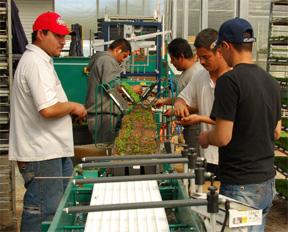Benefits of Effective Personnel Management
by Howard Rosenberg
“Rocket science is easy. It's managing people that's hard.”
— Jay Levine, aerophysics branch chief, Edwards Air Force Base

Does it really matter how agricultural labor is managed? What gains can be realized from improving personnel practices and skills? Some benefits were brought home to growers during a recent tour of two value-added agricultural processing firms. An advisor accompanying them describes the obvious differences:
“As we went through the first firm, employees were busy doing their jobs, but not with a lot of energy. The atmosphere felt cold. There was very little conversation between the managers conducting the tour and the working employees, and the relationship between them seemed very formal. Owners of the firm later talked about how tough it had become to make ends meet in their business. Labor costs were too high, productivity was down, rapid staff turnover was proving disruptive in many ways and good employees were always hard to find. They were thinking of relocating and rebuilding in another region that they believed would have a 'friendlier' business environment.
The tour then continued down the road a few miles to another firm that produces a similar product for the same market. The difference was astonishing. Not only were production lines flowing smoothly, but people had an energy to them, and there was a hum about the place. It seemed the very building was alive. We heard some task-related conversations spiced with occasional laughs, and managers and employees were interacting comfortably. Owners later talked about their recent growth, steady increases of both sales and profits, and plans for further expansion. Naturally, we all wanted to know the secret of their success. They replied without hesitation, ‘Our employees.’
Unlike the first firm we visited, this one had no problem finding the kind of employees it needed. In fact, well-qualified workers from other places often approached them looking for jobs, staff turnover was very low and productivity was high. The owners’ main labor concern was that some employees were accumulating a great deal of their annual vacation leave rather than taking it during the year.”
The growers who participated on this tour caught a glimpse of what many other practitioners, as well as researchers, have found: Effective personnel management can be a major competitive advantage and a lead indicator of a thriving business.
Who manages the agricultural labor force? More people have a hand in management than most of us realize. Their roles and the names by which they are commonly known differ across commodity sectors, parts of the nation, sizes of organization, forms of business, levels within the organization and cultural backgrounds. The property owner, general manager and designated human resource specialist make personnel management decisions, and so do the harvest manager, crew supervisor, foreman, chief mechanic, office administrator, the owner’s wise and deft spouse, and many production employees whose informal influence much outweighs their job titles.
The things these individuals do to manage labor cover an expanse of human activity — deciding how many people to hire, setting wage rates, recruiting employees, writing layoff and recall policies, filling out forms upon hire, explaining harvest and pruning techniques, providing field accessibility to water and portable toilets, checking on product quality, adjusting for family emergencies, choosing a replacement foreman, trying to cool hostilities, selecting an employee of the month, administering first aid, documenting performance strengths and weaknesses, running a meeting and bargaining with an insurance agent. Their duties are seemingly endless.
Howard Rosenberg is UC Cooperative Extension Specialist emeritus.
This article is an excerpt adapted by Steve Tjosvold from Ag Help Wanted: Guidelines for Managing Agricultural Labor, 2002, http://anrcatalog.ucdavis.edu/Labor-ManagementRelations/AHW001.aspx.












